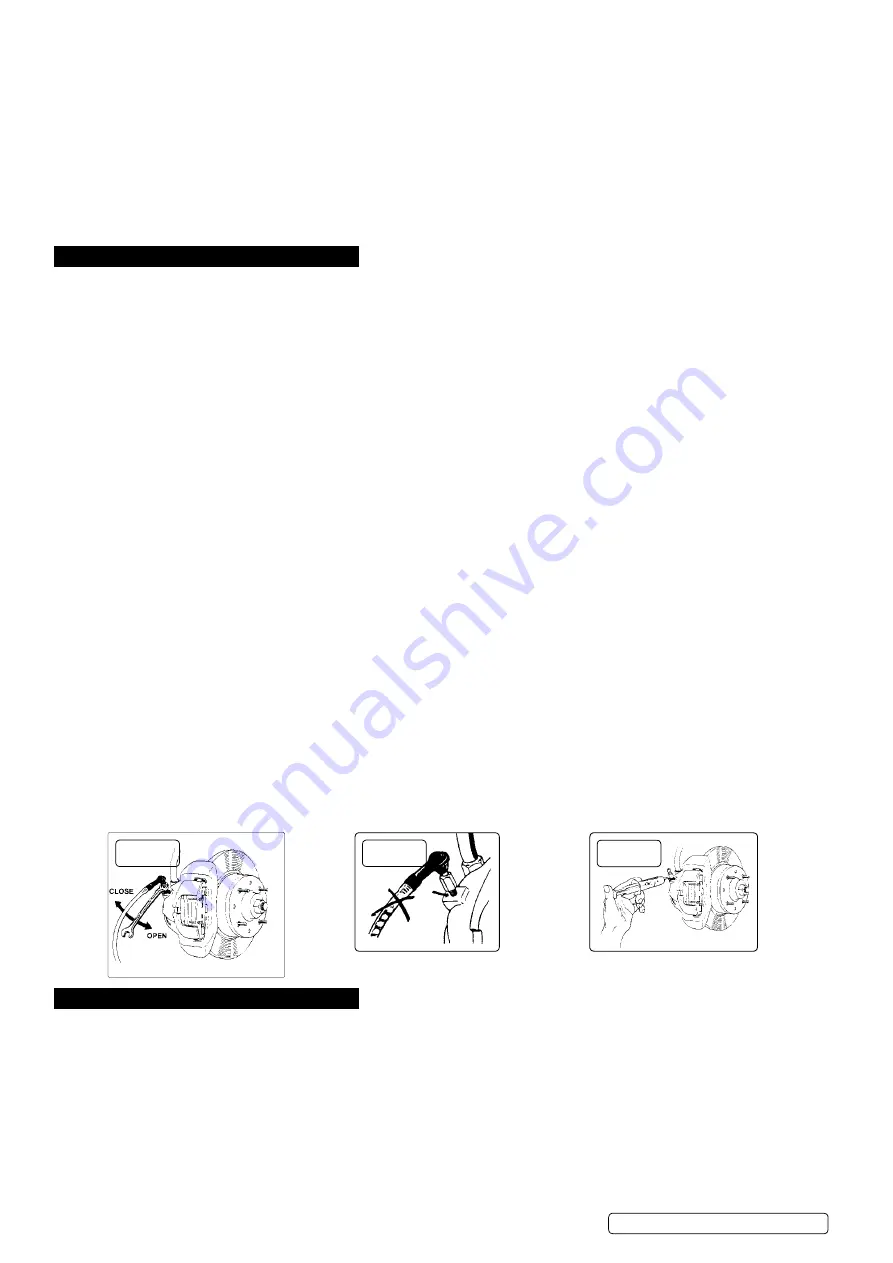
WARNING!
Before operating the extractor you must press the pressure release valve (fig.4) to dissipate any vacuum or pressure
remaining in the tank from previous use.
5.2.6.
To commence suction, place your foot over the foot rest to steady the unit and start to pump the handle up and down through its full
travel. As you pump up and down, the tank will begin to fill. Stop pumping and press release valve to prevent the unit overfilling.
5.3.
EMpTyING THE UNIT
NOTE:
Before emptying the extractor you must press the pressure release valve (fig.4
) to dissipate any vacuum or pressure
remaining in the tank.
5.3.1.
Carefully remove the suction probe from the dipstick tube using rag or tissue to prevent any oil drips soiling the engine bay.
Replace the dipstick.
5.3.2.
Disconnect the suction tube and the inlet coupling from the extractor body (fig.3).
5.3.3.
empty the extracted fluid into a suitable container. The fluid should be disposed of according to local authority regulations.
8
DO NOT
tilt beyond 90
0.
6. bRAkE bLEEDING
6.1.
bRAkE bLEEDING SAFETy
6.1.1.
dispose of waste liquids in accordance with local authority regulations.
6.1.2.
Always read and comply with the warnings on the brake fluid container.
6.1.3.
Wear eye protection and keep skin contact to a minimum. If brake fluid enters eyes rinse with plenty of water and seek medical
advice. If swallowed seek medical advice immediately.
WARNING!
Brake fluid is flammable - keep away from sources of ignition, including hot surfaces e.g. exhaust manifold.
WARNING!
Brake fluid will damage paintwork. Any spillage should be flushed with water immediately.
6.2.
bRAkE bLEEDING pROCEDURE
NOTE:
DO NOT
touch the vehicle’s brake pedal whilst bleeding the brakes.
Refer to the vehicle manufacturer’s instructions for brake bleeding and wheel sequence before proceeding. If no specific instructions
from the vehicle manufacturer exist, follow the instructions detailed below.
WARNING!
Familiarise yourself with the hazards of brake fluid - read manufacturer’s instructions on the container.
6.2.1.
Remove the lid of the vehicle’s brake fluid reservoir. Fill the reservoir to its maximum mark.
6.2.2.
Identify the brake bleeding tube which has a flexible plastic brake nipple connector at one end and a rubber adaptor at the other.
6.2.3.
Connect the brake bleeding tube to the top of the fluid extractor’s tank by pushing the black rubber adaptor into the fluid inlet coupling.
6.2.4.
Push the flexible plastic brake nipple connector onto the brake nipple on the first wheel and open the nipple about 1/4 of a turn. (See
fig.5).
6.2.5.
Turn on the air valve on the extractor. Press the suction start button (fig.3) to activate air operated unit or operate the pump handle on
manual models. A vacuum will be created which will draw the brake fluid from the vehicle’s brake system. operate the unit for a few
seconds only to avoid draining the vehicle’s brake fluid reservoir entirely.
IMpORTANT:
Check the level of brake fluid in the vehicle’s reservoir and top up regularly. If possible a reservoir top up device should be
fitted to the brake fluid reservoir.
6.2.6.
Continue to bleed the system and top up the reservoir until there are no air bubbles visible in the clear tube (See fig.6).
6.2.7.
Close the brake nipple (See fig.5).
6.2.8.
Remove the rubber pipe from the brake nipple.
6.2.9.
Repeat the process at each wheel in turn.
6.3.
CHANGING THE bRAkE FLUID
6.3.1.
Repeat the brake bleeding procedure as described above until the master cylinder reservoir is at its minimum level. Fill the reservoir with
new brake fluid and continue to bleed the system. Check reservoir level regularly.
6.3.2.
When new fluid can be seen in the clear tube tighten the brake nipple.
6.3.3.
Repeat this procedure at every wheel.
6.3.4.
When brake bleeding and/or fluid changing is complete, test action of the brake pedal to ensure that the brakes are working before driving
the vehicle.
6.3.5.
Apply copper grease to the brake bleed nipples before and after the brake bleeding procedure to eliminate the possibility of seized or
broken nipples when the brakes are next bled (See fig.7).
7. MAINTENANCE
7.1.
Keep the unit clean, wipe off any fluid spillage. Keep the suction tubes clean and clear of blockages. Check that all tubes, hoses and
connections are in good condition.
S
01168 Issue 1 25/10/19
Original Language Version
© Jack Sealey limited
fig.6
fig.7
fig.5

















